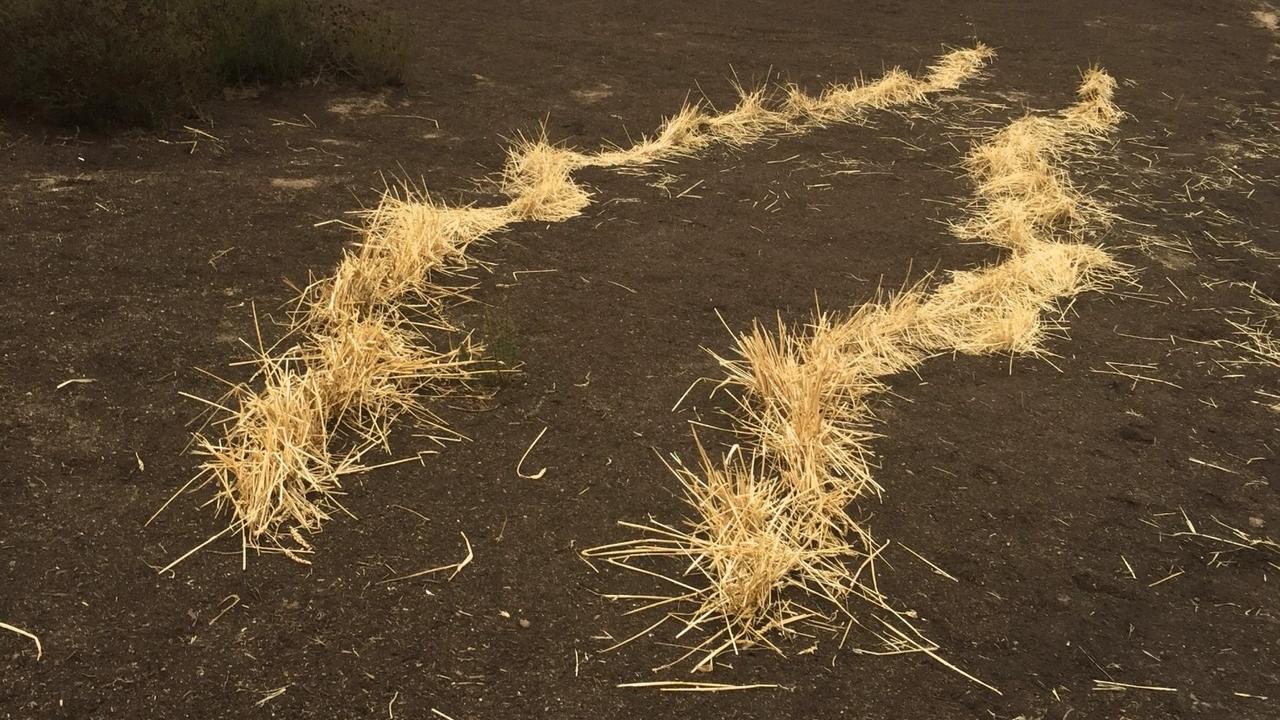Effective Erosion Control: Fish Scale Straw Mulch

With record breaking rain and snow across California during the 2016-2017 winter, residents are being confronted with devastating and costly erosion control issues. We will be covering some simple, do-it-yourself effective erosion control techniques to help you prepare for future rain events and limit the amount of soil and water loss off your site.
Fish Scale Straw Mulch

Lines of fish scale straw mulch installed to test sediment capture and erosion reduction.
We first learned about fish scale straw mulch* as an erosion control technique in David A. Bainbridge's essential tome on erosion control, A Guide for Desert and Dryland Restoration: New Hope for Arid Lands. Its simple process, materials and installation made it one of our top choices for DIY erosion control projects. *The term "fish scale" comes from the curved shape cut from the spade entering the soil.
Treatment Summary
Weed-free wheat or rice straw fish scale rows on contour are inexpensive and easy to install. These strips of vertical mulch help slow erosion, maintain sheet-flow, infiltrate runoff, and allow sediment to be caught by the vertical straw fish scale mulch. Combined in an alternating offset pattern on or near contour, these are easy to install using low-skilled or volunteer labor and resource needs are minimal.
Strips of fish scale straw mulch can be applied on contour at intervals up a hill at spacing ranging from 10-100’ getting closer as the site gets steeper. Hard, compacted ground is not conducive for this treatment; use a digging bar and do Vertical Mulch instead or another treatment.

Wheat growing from fish scale straw mulch installation.
Materials & Tools
- Two people capable of doing light digging (one is minimal, but it's nice to take turns and share the labor)
- Pointed shovel (spade) with good boot rests (a pick works in a pinch)
- Weed-free Straw bales (ideally native straw bales from your region)
- Seeds and mycorrhizae inoculant for plant establishment
Site Selection
Areas where sheet and rill erosion are occurring leading to bare ground, low litter amounts, low vegetative growth and poor infiltration.
Installation
- Select site and bring materials and labor.
- Along contour/perpendicular to the flow of water, from uphill side dig one slot with shovel, stomp and stand on shovel and have one person slide and press a bundle of straw vertically into the slot as the shovel is removed.
- Do not crimp or bend the straw. Place ends into hole.
- Smaller bundles work best. Don’t try to insert large bundles.
- Pack the dirt to hold the straw in place.
- Dig a slot adjacent to the first and repeat along a contour line (or close to) across the slope.
- Stagger additional slots up and down slope to add surface area, coverage, and effectiveness to the overall treatment.
- Optional:
- Seed with native seeds and mycorrhizae to help establish revegetation during flake installation.
- Combine with mulch, bark or seed-free compost.

Installing fish scale straw mulch erosion control treatments is relatively easy and fast (if soils are soft).
Inspection & Quality Control
- Make sure straw is placed vertically in slots and not bent halfway and jammed into slot.
- Check that soil is compacted and straw is secured in place.
- Add more rows or increase density of fish scales if mulch is not capturing sediment and slowing overland sheet-flow
Maintenance & Follow Up
- Visit annually and/or after storm events
- If sediment is collected and vegetation is being recruited well, consider adding more rows on hillside staggered between previous treatments
Feedback from Implementation
Our hopes for this treatment working well were immediately validated. After the first storm of the season in later November, we visited the site to examine sediment and seed recruitment for the fish scale straw mulch. Our takeaway? We should've installed more across a wider area! Both sediment and seeds were seen to be taking root on the upslope side of the erosion control treatment, testament to the erosion stopping powers of the vertical straw mulch.

In low litter areas, soil erosion is much greater thus sediment deposition increases.

Sediment, debris, seed and moisture all get slowed and/or captured upslope of treatment.

Seed recruitment improves and soil saturation extends thanks to fish scale straw mulch installation.

Sediment deposition upslope from fish scale straw mulch treatment.


Without this treatment, seeds would have continued washing down the hill along with sediment and water.

Comparing growth over an unseasonably wet winter of fish scale straw mulch treatment.
Conclusion
Using fish scale straw mulch as an erosion control technique shows great promise. Ideal application areas are denuded open space, sloped areas showing formation of rills. This is an easily transferable skill and is perfected with very little time spent doing it making it great where low-skilled volunteer labor is in plenty or easily available. Combined with straw wattles, soil pitting, swales (where appropriate) and other erosion control techniques, we can keep soil on our land longer, and possibly renew and heal our degraded water cycles. Explore more fish scale straw mulch photos on our Flickr album.
FREE REPORT - 8 Ways To Save Water In Your Landscape
Learn the techniques we use on a daily basis to maximize your water budget.
